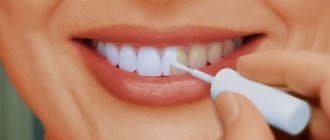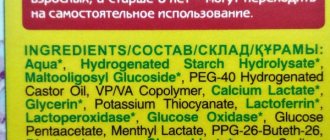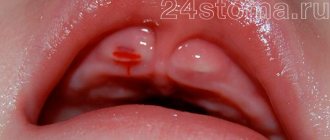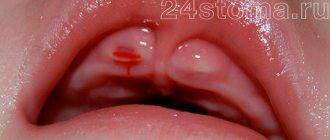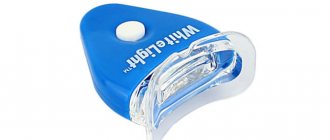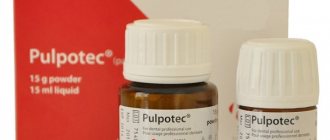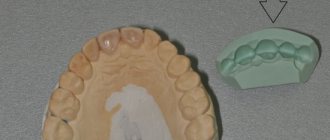Indications and contraindications Types After At home Is it harmful?
For children and pregnant women Differences from remineralization Effect Care after the procedure Fluoridation of teeth
- an effective way to protect teeth from caries and strengthen the enamel structure with the help of certain fluoridated agents.
Fluorine is an important element for the body; the daily requirement for it is about 3 mg. It comes to us with water and some food products. If it is not enough, then the connection between calcium compounds concentrated in the enamel is destroyed, the surface becomes vulnerable, which leads to increased sensitivity and damage to the tooth tissue.
Indications and contraindications
Indications for fluoridation of teeth in dentistry:
- increased sensitivity of enamel, reaction to cold, hot, sour and sweet foods;
- susceptibility to caries disease, as a preventive measure for caries;
- after using braces and other orthopedic structures;
- lack of fluoride;
- after teeth enamel whitening.
Contraindications for the procedure when there is only harm from fluoridation:
- allergy to fluoride-containing drugs;
- excess fluoride in drinking water;
- fluorosis (change in tooth color due to oversaturation of fluoride from childhood).
Types of dental varnishes for teeth
Whitening cosmetic varnishes
Professional whitening, which is offered by dental clinics, has one drawback - high cost. But there are options on how to achieve the effect of a “Hollywood” smile at minimal cost. Teeth enamel whitening varnish will help with this.
It makes teeth white from the first application, brightening them by at least 10 shades and giving a glossy shine. Products from different manufacturers may differ in the degree of whiteness and duration of action, but on average, one coat of teeth with varnish is enough for a maximum of a day. The principle of action is similar to nail polishes: the teeth are temporarily stained and, as a result, become whiter.
After the composition dries, a white film coating forms on the teeth, which can be easily removed with a toothbrush if desired, but can also be easily removed along with solid foods and drinks. The effect of whitening varnish-paint does not affect your own enamel; it will not relieve tooth sensitivity, if any.
The coating can be applied to restorations: on fillings, veneers, and crowns, it will have the same properties as on regular teeth.
The composition of different teeth whitening varnishes may vary, but some components are present in all products:
- film former;
- coloring component.
With repeated use, such varnishes can lighten your own tooth enamel by several tones. Manufacturers assure that, in addition to coloring, such varnishes have a remineralizing effect due to a special additive (hydroxyapatite), that is, they help restore and strengthen tooth enamel. In addition, the film has antiseptic and bactericidal properties, thus, while present on the teeth, it protects them from cervical caries.
Main indications for the use of whitening varnish:
- pigment spots on enamel;
- darkening of enamel from tobacco, coloring foods and drinks;
- difference in color of fillings and crowns.
Teeth whitening varnishes are good as a temporary solution, for example, for photo shoots, special events or public appearances when you need to look perfect. Safety: whitening varnishes do not contain acetone and other chemically hazardous components, therefore they do not damage tooth enamel and mucous membranes, and do not cause discomfort during application and presence in the mouth.
Note that whitening varnishes are not effective for problems such as moderate and severe forms of fluorosis, enamel hypoplasia, severe chips: in this case, tooth defects cannot be masked with several layers of varnish. With such defects, only ceramic restoration can improve the aesthetics.
Fluoride varnishes
Fluoridation is a procedure that is performed in a dental office. Goes in combination with professional oral hygiene.
When areas of enamel demineralization appear on a tooth, it becomes sensitive: it reacts to cold, hot, acidic foods and drinks. Dentists use fluoride preparations that seal open dentinal tubules, eliminating increased sensitivity.
Problems that fluoride varnish solves:
- decreased enamel sensitivity;
- prevention of caries;
- preventing further development of caries when it is at the spot stage.
Unlike whitening varnishes, fluoride varnishes are absolutely transparent on the teeth and do not have a whitening effect, but due to the preliminary removal of soft and hard plaque from the teeth during professional hygiene, the enamel is slightly lightened. Fluoride varnish creates a colorless protective film on the tooth surface that prevents the harmful effects of bacteria.
Fluoride-containing preparations are not applied to crowns, veneers, or dentures. It is recommended to begin fluoridation procedures in childhood, from the moment the baby teeth erupt, as this will protect the rudiments of permanent teeth. Fluoridation is also carried out for pregnant women, since the drugs are safe and do not have a negative impact on the health of a woman expecting the birth of a child. Fluoridation is especially recommended after removal of braces and clinical whitening.
The composition of fluoride varnish includes:
- sodium fluoride;
- chloroform;
- shellac;
- ethanol;
- fir resin.
Many have heard about the dangers of fluoride, and we have already talked about the consequences of its excess in the body. Dentists agree that the use of toothpastes with fluoride at a certain concentration of this element has a bad effect on tooth enamel and on health in general, especially if there is an increased content of fluoride in drinking water in a given region. But the concentration of fluorides in fluoride varnish is very small and cannot harm dental health. Therefore, fluoridation is recommended for the population even in regions with high fluoride content in water.
Remineralizing varnishes for children
Children's dental varnishes for remineralization can be distinguished into a separate category. Varnishes for children's teeth are available in various flavors, so that the little patient has a pleasant impression of visiting the doctor, and he does not feel afraid of the necessary medical procedures. The products contain xelitol, which allows you to fight pathogenic bacteria in the oral cavity some time after application.
Types of fluoridation
There are two types of fluoridation: superficial and deep fluoridation of teeth.
Simple fluoridation of teeth
There are three simple methods used in dentistry:
- applying fluoride varnish to the tooth surface with a brush
. An invisible film is created. The procedure is repeated several times. The cost of fluoridation with varnish is affordable for everyone. Despite the fact that fluoride varnish therapy has been used for a long time, the remedy is still working and relevant. - electrophoresis
.
Better tissue permeability for fluoride molecules is achieved with small electrical pulses. At the first stage, electrodes impregnated with 10% calcium are attached to the teeth, at the second, this action occurs with sodium fluoride 2-4%. 10 procedures
are usually enough. - individual mouth guards
filled with a fluoride-containing preparation.
They are made quickly during a visit to the dentist, an impression is taken and the trays harden to the shape of the patient’s teeth. The material is elastic. The doctor fills the trays with a solution containing a photor. The patient puts them on for 5-10 minutes. 10 procedures
are recommended .
Deep fluoridation of enamel and dentin
A simple method is superficial; fluorine particles are large and cannot penetrate deeply. Deep fluoridation of teeth uses a solution of magnesium fluoride silicate whose molecular size is so small that the product acts deeper in the tissues, enriching them with a higher concentration of fluoride. Fluorine and calcium create strong crystalline bonds. At the end of the procedure, the teeth are coated with a “sealing” preparation. Fluoride compounds remain under it for a year and a half.
Conduct deep fluoridation up to twice a year
, not more often. The effect of this method compared to the simple one is 5 times higher.
Prices for pediatric dentistry
| Child therapy | |
| Children's professional oral hygiene | 2,200 rub. |
| Filling teeth with glass ionomer cement (Fuji, Vitremer) | 1,500 rub. |
| Dental treatment using vital amputation in one visit (excluding anesthesia) | 3,600 rub. |
| Seal “Dyract” | 2,200 rub. |
| Pulp amputation with placement of a therapeutic bandage | 1,200 rub. |
| Mechanical and medicinal treatment of carious cavity | 500 rub. |
| Application of devitalizing paste | 500 rub. |
| Deep fluoridation of all teeth | 2,500 rub. |
| Carrying out the resorcinol-formalin method (one session) | 700 rub. |
| Filling root canals with paste (one canal) | 300 rub. |
| Carrying out the method of silvering baby teeth (one tooth) | 200 rub. |
| Application of medicinal paste “Pulpotek” | 1,000 rub. |
| Temporary chemical filling | 300 rub. |
Is it possible to do fluoridation at home?
The price of dental fluoridation in Moscow using the deep method will cost 2000-3000 rubles (all teeth), but you can do it yourself. Preparations for fluoridation at home are freely sold in pharmacies and specialized stores.
- Fluoride varnish
. Follow strictly the instructions, which indicate how and how many times to apply fluorine-containing varnish. - Therapeutic and prophylactic pastes and gels
. The composition should contain sodium fluoride, amino fluoride and other fluorides. We must remember that you cannot use such a paste for a long time so that there is no excess of fluoride in the body. Be sure to alternate with other types.
For effective fluoridation, it is better to consult with your dentist about choosing medications for home use. The result will be more lasting if you have professional teeth cleaning done beforehand to remove plaque and tartar.
Indications for the procedure
Now we need to consider the question of what dental varnish is used for. Fluoride varnish can be used by everyone without exception, even when there are no prerequisites for caries. This is necessary to prevent its occurrence.
The application procedure is necessary in the following cases:
- preventing the occurrence of dental diseases in children and adolescents living in places where there is insufficient fluoride in the water;
- sensitivity of teeth to external factors;
- in the event that there are defects in the teeth that appear as a result of the harmful effects of bacteria. The tool will help eliminate this problem;
- consequence of mechanical impact;
- after a negative result of ultrasonic teeth cleaning;
- non-carious lesion of enamel;
- before prosthetics, during grinding of teeth.
Differences from remineralization
Any method of dentin fluoridation is part of remineralization, artificial saturation of the enamel structure with micro- and macroelements by applying dental pastes, gels rich in calcium, fluorine, phosphorus, magnesium, zinc, etc. to the surface. The procedures have the same goal - prevention of caries, strengthening of enamel and replenishment microelements lost during demineralization. If pastes and gels for remineralizing dental tissue contain several components, then fluoridation agents contain fluoride ions.
Fluoridation increases the rate of remineralization several times. Since fluoride varnish seals dentinal tubules, the use of mineral complexes should be separate. First, remineralization, the final stage is fluoridation of teeth.
Tips for strengthening enamel
Taking care of your teeth should include proper nutrition. Without it, preventative medical procedures will be of little benefit. A complete menu to strengthen teeth enamel should include the following foods:
- dairy products: they all contain phosphorus and calcium;
- hard root vegetables - carrots, radishes, apples, cabbage: chewing activates the secretion of saliva, which cleans the crown of the teeth;
- parsley: essential oils of this plant suppress the activity of microorganisms, which affects the cleanliness and safety of teeth and the strength of their coating;
- green tea: tea leaves contain fluoride in their structure, which prevents the formation of plaque and the accumulation of bacteria on the teeth;
- chicken eggs and seafood: they contain iodine, which helps strengthen the enamel.
It is necessary to take care of strengthening teeth from the appearance of the first primary incisor. Those parents who consider their baby’s baby teeth to be temporary and unimportant are deeply mistaken. It is the health of baby teeth that determines the health of future molars.
After six years, a child definitely needs to prevent caries using the drug Fluorlak Omega and other gels/solutions for teeth. Treatment must be prevented by preventing diseases, then dental health will be strong and the enamel will be strong.
Sources used:
- Groshikov M.I. “Non-carious lesions of tooth tissue.” - M.: Medicine, 1985.
- Preventive dentistry / I.K. Lutskaya. - Moscow
- “Pediatric therapeutic dentistry. National leadership" (Leontyev V.K.)
- The European Academy of Pediatric Dentistry (USA)
Effect of fluoridation
Although tooth enamel contains less fluorine than calcium, it is simply necessary for the strength of the enamel. When fluoridating dentin, fluorine combines with tissue molecules and forms fluorapatite hydroxide, which is more resistant to acids. Namely, acids (acidic foods, waste products of bacteria in dental plaque) destroy tooth tissue, demineralization occurs, and micro- and macroelements that play an important role are washed out. Timely fluoridation of dentin prevents this process.
After the procedure:
- enamel becomes stronger;
- natural shine appears;
- susceptibility to caries is minimized;
- Calcium and phosphorus are better absorbed by dental tissue and retained there;
- enamel sensitivity decreases.
Why use a fluoride-based protectant?
Fluoridation is prescribed to young children to avoid tooth decay. After all, it is very important to keep the milk units healthy until they are replaced. How many years the molars will last largely depends on their condition.
Other indications for enamel coating include:
- Restoration of the natural mineral structure of hard tissues. Fluorine is able to “pull” the necessary minerals from saliva, due to which an active saturation reaction occurs.
- Prevention of premature crown wear. If the tooth is healthy, the problem of abrasion will not arise, so you need to monitor the condition of its tissues.
- High sensitivity. It can be hereditary or provoked by rough mechanical influences performed by dental procedures (for example, whitening).
- Wedge-shaped defect. With this diagnosis, tissue is destroyed in the cervical area. Moreover, the destructive process is in no way related to caries.
It is advisable to cover your teeth with a protective coating after professional ultrasonic cleaning. In general, this procedure will be useful to almost all patients of the dental clinic (with the exception of those who have contraindications to its implementation).
What is fluoride varnish?
Fluoride varnish is a specialized product. It is used in dental clinics for therapeutic and preventive purposes. However, it can be purchased at some pharmacies. The active ingredient in fluoride varnish is sodium fluoride, NaF. Recently, conventional fluoride varnish has been replaced by products created on the basis of aminofluoride. This is a new product that is included in the products of some oral care companies. They contain additional components: shellac, ethyl alcohol, pine extract.
Fluoride varnish is produced in dark glass bottles with a capacity of up to 30 ml. It is a dark thick liquid. The kit is equipped with a brush or other tool for applying to teeth.
Is it possible to undergo the procedure during pregnancy?
Often during pregnancy, the general condition of teeth deteriorates significantly. Due to large-scale hormonal changes occurring in the body of the expectant mother, the enamel loses a lot of calcium, becomes weak and susceptible to external irritants. During this period, fluoridation becomes especially important - fluoride varnish helps saturate the tissue with useful components and inhibits the process of its demineralization.
“After pregnancy and childbirth, such tiny cracks appeared on my teeth. Then I noticed that the enamel began to wear off and began to react sharply to cold and hot drinks. Then my dentist prescribed fluoridation. Literally three sessions. It helped a lot. My teeth have definitely become stronger and more durable. I think I’ll repeat it in six months for prevention.”
Irina_Fom, from correspondence on the forum www.32top.ru
Treatment of enamel with fluoride-containing compounds is possible at any stage of pregnancy. And the health of her child depends on how carefully the expectant mother monitors her health.

